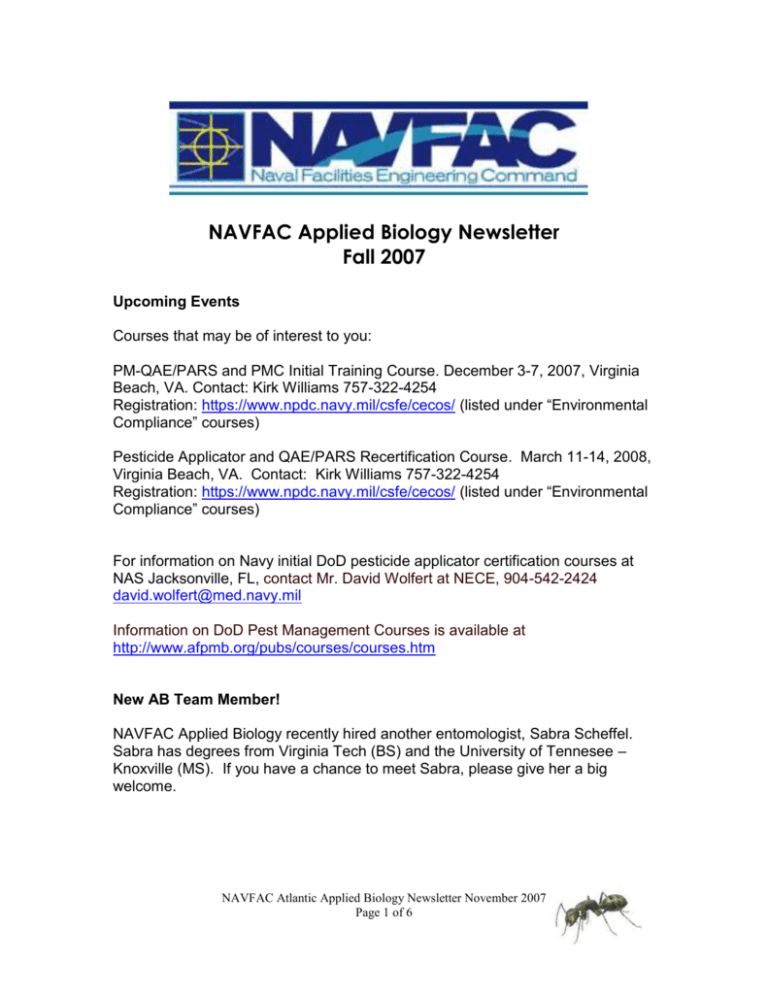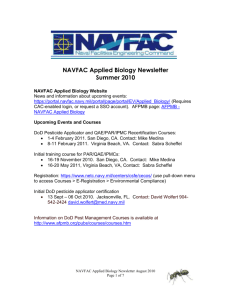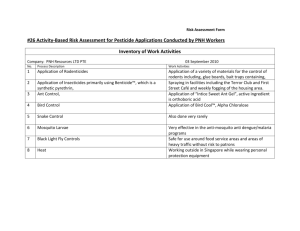NAVFAC Applied Biology Products and Services
advertisement

NAVFAC Applied Biology Newsletter Fall 2007 Upcoming Events Courses that may be of interest to you: PM-QAE/PARS and PMC Initial Training Course. December 3-7, 2007, Virginia Beach, VA. Contact: Kirk Williams 757-322-4254 Registration: https://www.npdc.navy.mil/csfe/cecos/ (listed under “Environmental Compliance” courses) Pesticide Applicator and QAE/PARS Recertification Course. March 11-14, 2008, Virginia Beach, VA. Contact: Kirk Williams 757-322-4254 Registration: https://www.npdc.navy.mil/csfe/cecos/ (listed under “Environmental Compliance” courses) For information on Navy initial DoD pesticide applicator certification courses at NAS Jacksonville, FL, contact Mr. David Wolfert at NECE, 904-542-2424 david.wolfert@med.navy.mil Information on DoD Pest Management Courses is available at http://www.afpmb.org/pubs/courses/courses.htm New AB Team Member! NAVFAC Applied Biology recently hired another entomologist, Sabra Scheffel. Sabra has degrees from Virginia Tech (BS) and the University of Tennesee – Knoxville (MS). If you have a chance to meet Sabra, please give her a big welcome. NAVFAC Atlantic Applied Biology Newsletter November 2007 Page 1 of 6 Pesticide Use Reporting We are currently gathering and analyzing pesticide use data for the FY07 Measures of Merit report (MOMs) required by the DoD. A member of our team may be contacting you if we have questions about or are missing some of your data. Navy and environmental regulations require that you report all pesticide uses monthly to your installation Pest Management Coordinator (PMC). PMCs must report usage to NAVFAC Atlantic Applied Biology. Please send your updated spreadsheets to your regional POC. Mosquito Surveillance Sabra Scheffel spent the summer conducting mosquito surveillance for Richmond County Mosquito Control in Augusta, GA. This was Richmond county’s first year of doing surveillance and an important step towards enhancing their mosquito control program. One West Nile Virus (WNV) positive mosquito pool was collected in August, which provided them with an early detection of the virus, and they were able to increase control in that area and prevented any human cases. Surveillance is an important part of any pest management plan, providing information that can be used to determine the best treatment option. Georgia has had a substantial increase in the number of human cases of WNV this year. Due to the unusually warm temperatures we have had this Fall, mosquitoes can still be biting in some of the southern states. Dealing with Spiders The Fall weather is upon us, and some of our activities have been reporting increased problems with spiders inside buildings. Spiders are generally not a big pest control issue because only two types, the widow spiders and the brown recluse, are of any medical concern. Most of us are familiar with the black widow, but there are other species of widows including the brown and red widows. Widow and brown recluse spiders are non-aggressive and will bite humans only defensively. Most bites occur when we accidentally contact the spiders with exposed skin. The most commonly recommended treatment for isolated spider cases is mechanical (squash them). There are not any very good chemical options for control of spiders. However, pesticides can NAVFAC Atlantic Applied Biology Newsletter November 2007 Page 2 of 6 provide at least temporary relief and their use is warranted where there is a medical threat, such as an ongoing problem with black widow or brown recluse spiders. Black widow spiders are usually easily identified by the general public. Identification of the brown recluse is more difficult, and most spiders suspected by lay persons of being brown recluses are in fact harmless species. Pest controller can survey for the presence and frequency of brown recluse spiders with sticky traps, and send off specimens to NAVFAC Applied Biology or NECE for ID as necessary. Non-chemical measures should be taken to prevent the invasion of facilities with spiders. These include sanitation around the building. Keep weeds and ornamental plantings cut back from the outside of the structure, especially around ground level. Also keep excess mulch and debris away from the building. Caulk or seal any openings, cracks, or crevices on the outside of the building. Indoors, clean up any clutter or debris and seal any cracks or crevices that may provide hiding areas for insects or spiders. These types of preventive measures typically fall outside of the responsibility of pest control personnel, so it’s important that we coordinate with facilities maintenance or anyone who might be responsible for the care of a building and it’s grounds. If chemical control is necessary, apply a residual chemical to the outside walls at or near ground level, and especially around window and door openings, utility chases, and other openings in the structure. Indoors, treat in areas where spiders typically live or hide such as baseboards, corners, storage areas and closets, behind and under lockers, refrigerators, and other large appliances or equipment, and any similar areas. Spraying will provide only temporary control, but this may be sufficient because of the seasonal nature of the problem as we move into the winter months. Spraying may be repeated if spiders increase to a troublesome level, but no more often than the label directs. There are several products with residual activity labeled for indoor/outdoor use in the control of spiders that should give adequate control. These include Demon WP (100-990), Demand CS (100-1066), Suspend SC (432-763), and Onslaught (1021-1815). Your may already have on hand a general insecticide labeled for spiders, so check the labels of products you have in stock before purchasing something new. Generally these will be sprayable pyrethroids. Finally, people have differing sensitivity to the presence of spiders. A few spiders that may go unnoticed by one individual may be perceived as a serious problem by another individual. Try to educate your customers on the principles of IPM and on what they can do to help keep spider numbers down. Remember, if you are a licensed applicator it is your responsibility to make an objective assessment of the situation and make any chemical applications in an appropriate and responsible manner. For more information see: Widow Spiders from Virginia Cooperative Extension Brown Recluse Spiders from Wikipedia NAVFAC Atlantic Applied Biology Newsletter November 2007 Page 3 of 6 MRSA or Spider Bite? Unless you’ve been living at Number 4 Privet Drive in the cupboard beneath the stairs, chances are that you’ve heard of increasing problems with the drug-resistant bacterium known as MRSA. But what does this mean to a muggle like you? If you’re suddenly with so many painful boils and carbuncles all over your body that you think you’ve been hexed by You-know-who, chances are you have been infected with MRSA. Methicillin-resistant Staphylococcus aureus (MRSA) is a virulent strain of a common skin bacteria. It is readily spread from person to person by skin-to-skin contact, crowded conditions, or the sharing of contaminated personal items. It is also referred to as multiple-resistant Staph. aureus because of its resistance to many common antibiotics. Aurors from the Ministry of Health first detected MRSA in 1961. The majority of MRSA infections are acquired in hospitals. However, in recent years community-acquired MRSA has become more common, infecting people with no recent connection to health care facilities. MRSA is spread readily in facilities such as military barracks, where conditions are crowded and bathroom facilities are shared. The most common (and least serious) manifestation of MRSA infection is a skin infection, which appears similar to a pimple, boil or spider bite. Instead of healing normally, the pimple or boil develops into a large pus filled sore, or an abscess under the skin. More serious cases can result when bacteria gain access to and infect interior organs and tissues. MRSA is of interest to the pest control community because the expanding boils common to skin infections are often misdiagnosed as spider bites – brown recluse spider bites in particular. If you are getting repeated complaints of “spider bites” from a particular barracks or facility, but no one recalls seeing the spider that bit them it is likely that the real problem is MRSA. Place sticky glue boards in suspect areas and encourage affected individuals to see medical professionals. Your surveillance and the diagnosis from competent medical staff will let you know if you have the unusual case where a chemical control approach for brown recluse spiders is necessary. Other News of Interest Pest-Proofing Tips for Fall Bug Spray Fumes prompt Classroom Evacuation Bugged by Odorous House Ants NAVFAC Atlantic Applied Biology Newsletter November 2007 Page 4 of 6 Choose the New name for the online pesticide use reporting system! Our readers suggested several names for the new online pesticide reporting system. Now is your chance to vote for your favorite. Choose a name from the list below, and email your vote to steven.p.holmes@navy.mil 1. PestPortal 2. Navy PestWeb 3. NOPERS (Navy Online Pesticide Reporting System) 4. ROACHES (Reporting Online Applied Chemicals Electronic System) 5. PERK (Pesticide Electronic Record Keeping) 6. POP (Pesticide Online Portal) Useful Links AFPMB – Armed Forces Pest Management Board homepage Army Pest Management Timely Topics National Pest Management Association Naval Safety Center Applied Biology Team Members and regional POCs Sherrie Bartku sharon.bartku@navy.mil 757-322-4796 Head, Applied Biology Section Steven Holmes steven.p.holmes@navy.mil 757-322-8295 Midwest region and Marine Corps Jack Markham jack.markham@navy.mil 757-322-4882 MidLant Mike Medina michael.j.medina1@navy.mil 619-532-1157 Southwest and Northwest Steve Robertson steve.b.robertson@navy.mil 757-322-4752 Europe/SW Asia Kirk Williams kirk.williams@navy.mil 757-322-4254 Southeast region Sabra Scheffel sabra.scheffel@navy.mil 757-322-4320 Dan Cecchini joseph.cecchini@navy.mil 757-322-4887 Program Manager NAVFAC Atlantic Applied Biology Newsletter November 2007 Page 5 of 6 NAVFAC Applied Biology Products and Services Pest Management Provide technical assistance to troubleshoot and solve pest problems. Conduct required pest management program reviews to ensure effectiveness, efficiency and safety of the program. Provide guidance in structure and landscape design and construction to prevent pest infestations. Conduct extended on-site consults (reimbursable). Pesticide Compliance Prepare integrated pest management plans (reimbursable). Prepare pest control contracts (reimbursable). Review installation integrated pest management plan (IPMP). Review pest control and construction contract specifications, agriculture and PPV housing lease agreements, natural resources contracts, and other documents involving pest management. Approve pesticides for use on installations. Support pesticide compliance programs. Manage pest management record keeping and reporting. Training Provide pest management training to recertify pesticide applicators and train pest management coordinators and pest control contract Quality Assurance Evaluator (QAE) / Performance Assessment Representatives (PAR) and others involved in pest management. Provide non-FIFRA initial certification and FIFRA/non-FIFRA recertification for OCONUS activities (reimbursable). Other Support for Marine Corps and other services (reimbursable). NAVFAC Atlantic Applied Biology Newsletter November 2007 Page 6 of 6






